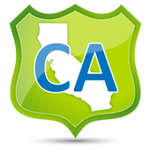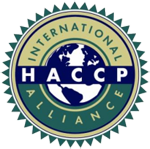California Food Safety State Requirements
 California Food Handler Training
California Food Handler Training
California law requires all food handlers in the retail food service and hospitality industry - who are involved in the preparation, storage, or handling of food - obtain a California Food Handlers Card.
California Food Manager Certification
California law requires that a person-in-charge or owner of a retail food establishment be a Certified Food Manager (CFM) as outlined in the California Health Code by successfully passing an ANSI-Accredited food safety certification exam.
California Food Safety Bills
- As of July 1, 2011, SB 602 requires, every California Food Handler who is involved in the preparation, storage, or service of food in a food facility has to take a California state-certified food handler course and pass an authorized test.
- The SB 303 bill made technical changes to the Food Handler Card Law that required training providers to be accredited through American National Standards Institute (ANSI).
California Food Safety Local Requirements
- Riverside and San Bernardino County requirements vary by city and county – which have local food handler card programs.
- San Diego County recently approved changes to accept our Learn2Serve training.
California Food Safety Regulations
California Food Handler Card Law Guidelines - 2011 (PDF)
URL: http://www.ccdeh.com/resources/documents/food-safety-guidelines-1/707-california-food-handler-guidelines-april-2011-1/file
Food Handler Training
Course Description
Most people working in restaurants, on a mobile food truck, caterers, and non-restaurant facilities need food safety training or a food handlers card. To get that card, food handling and serving personnel should complete food handling training. After completing the course, they have to present the food handlers certificate to their local authority and pay the required registration fees.
Food Handler Training is often intended for entry-level professionals in the food service industry, such as servers, chefs, cooks, cashiers, food truck workers, mobile food vendors, caterers, and even convenient store (c-store) clerks. The Food Handler Certificate will require the learner to complete a brief 2-hour training course covering basic food safety principles. At the conclusion of the course, the learner will be tested on their knowledge of the content and learning outcomes. Upon successfully passing the exam, the learner will be issued a Food Handler’s Certificate document (or card).
The Learn2Serve.com ANSI Certified Food Handler course will discuss various food safety issues, regulations, and techniques to maintain a food-safe environment. It will help you to better understand how handling food correctly is not only the law, but it improves safety and reduces risks.
Credit Hours: 2 hrs
Cost: $7.00
Course Outline
At the conclusion of the ANSI Certified Food Handler Certificate program, you should be able to:
- Identify biological, physical, and chemical contamination.
- Identify foodborne illnesses, signs of food spoilage, types of food prep contamination, and proper temperature control methods.
- Safely store and prepare meat, poultry, and vegetables.
- Demonstrate effective food handling techniques that promote cleanliness and safety in food establishments.
- Discuss the importance of proper personal hygiene in the workplace.
- Implement appropriate procedures to receive and store food.
- Summarize practices for properly cleaning and sanitizing food contact materials and surface.
Upon successful completion of the course and the exam, you will earn your food handler certificate of completion from your training page.
Food Safety Manager Course & ANSI-CFP Certification Exam
Food Manager Training Course
The Food Safety Manager Principles Course provides a foundational knowledge of the FDA Food Code and covers foodborne hazards and pathogens, cross contamination, proper preparation and temperature controls, proper hygiene, proper cleaning and sanitation methods, regulations, and the proper techniques to maintain a food-safe environment.
Audience: Experienced professionals in the food service industry, such as owner, manager, person-in-charge (PIC), chef, cook, or any employee.
Course Outline
- Lesson 1: Introduction to Food Safety
- Lesson 2: Biohazards, Foodborne Disease, and Food Spoilage
- Lesson 3: Contaminants
- Lesson 4: Food and Temperature Control
- Lesson 5: Employee Health, Hygiene, and Training
- Lesson 6: Purchasing, Receiving, and Storing Food
- Lesson 7: Cleaning and Sanitizing
- Lesson 8: Pest Control
- Lesson 9: Facility Design
- Lesson 10: HACCP System Basics
- Lesson 11: FDA Guidelines for Developing a HACCP System
- Lesson 12: Developing, Implementing, and Maintaining a HACCP Plan
- Lesson 13: Seafood HACCP
- Lesson 14: Consumer Steps to Safer Seafood
ANSI Certification Exam
To be certified as a food manager, the individual must pass an accredited food safety examination - administered by a certification provider.
The Learn2Serve Food Protection Manager Certification is approved by the American National Standards Institute and the Conference for Food Protection (ANSI-CFP). With the exception of Connecticut, this accredited exam is accepted in all states/jurisdictions that have mandatory certification requirements for Food Management Professionals. Reference: ANSI (American National Standards Institute)
Help with Exam
We have partnered with PSI - a global testing, certification, and licensing provider. The exam is proctored at a PSI test center location.
After purchasing the exam, you should receive an email from PSI instructing you how to schedule your exam. If you do not receive this email, please contact support at 877.881.2235.
You can also click here to schedule exam online at a testing center near you.
Upon successful completion of the exam with a passing score, you may download and print a proof of completion document. The official certificate will be mailed within 15 business days of completing the exam.
HACCP Food Safety Courses
HACCP for Retail Food Establishments
Credit Hours: 16 hrs
Cost: $125.00
Course Objectives
After completing this course, the student will be able to:
- Identify the biological, chemical, and physical hazards in the food offered to consumers in a food system.
- Determine which hazards are significant risks.
- Determine, write, and validate adequate controls for those hazards.
- Write a Food Safety Management Plan that provides an appropriate level of protection for customers.
- Train and supervise employees to perform controls that strive for zero customer illness or injury during the life of the business.
Course Outline
This course will discuss the following topics:
- Lesson 1: The Food Safety Problem
- Lesson 2: The HACCP Approach to Food Safety
- Lesson 3: The Food Safety Management Plan
- Lesson 4: Physical Hazards in Food
- Lesson 5: Chemical Hazards in Food: Part 1
- Lesson 6: Chemical Hazards in Food: Part 2
- Lesson 7: Biological Hazards: Part 1
- Lesson 8: Biological Hazards: Part 2
- Lesson 9: Biological Hazards: Part 3
- Lesson 10: Biological Hazards: Part 4
- Lesson 11: Personal Hygiene and Control
- Lesson 12: Cleaning and Maintenance
- Lesson 13: Supplies
- Lesson 14: Menu HACCP
- Lesson 15: Recipe Engineering
Completion of Course
Upon successful completion of the course, the certificate of completion will be available from the training page.
HACCP: State-of-the-Art Approach to Food Safety
This course meets the regulatory requirement of compliance with the 2013 FDA Food Code and the USDA Requirements for School District HACCP Plan Implementation.
Credit Hours: 4 hrs
Cost: $50.00
Course Objectives
After completing this course, the student will be able to:
- Identify the key points of HACCP
- Identify the causes of food borne illness
- Explain the 7 HACCP principles
- Apply standard operating procedures for food safety and food defense in your operation
- Follow prerequisite programs for food safety
- Identify the three classifications of recipes
- Apply critical control limits
- Determine critical control points
- Determine effective corrective actions
- Complete monitoring forms
Course Outline
The course consists of the following seven units:
- Unit 1: Introduction to HACCP
- Unit 2: Food Borne Illness
- Unit 3: The Seven HACCP Principles
- Unit 4: Identifying Hazards and Determining Critical Control Points
- Unit 5: Critical Limits, Monitoring and Corrective Actions
- Unit 6: Verification and Record Keeping
- Unit 7: Overcoming Barriers to HACCP Implementation
Completion of Course
Upon successful completion of the course, the certificate of completion will be available from the training page.
Seafood HACCP
The Seafood HACCP Course follows the Seafood HACCP Regulation that defines processing as handling, storing, preparing, heading, eviscerating, shucking, freezing, changing into different market forms, manufacturing, preserving, packing, labeling, dockside unloading, or holding fish or fishery products.
Information in this course comes from the Hazardous Analysis and Critical Control Point Principles (HACCP) and Application Guidelines adopted by the USDA and FDA. Code of Federal Regulations 21 CFR Part 123 - Seafood HACCP Regulation - requires all seafood companies (domestic as well as international exporters to the United States marketplace) process products in accordance to HACCP principles as specified in the regulation.
Credit Hours: 1 hr
Cost: $75.00
Course Objectives
After completing this course, the student will be able to:
- Describe why a Hazard Analysis and Critical Control Point (HACCP) management system is an effective means for assuring food safety.
- Identify and distinguish between prerequisite programs for a HACCP management system.
- Discuss areas in which employees must receive education and training in order to understand their roles in producing safe foods.
- Identify the five preliminary tasks to be completed in the development of a HACCP plan before applying principles to a specific product or process.
- Discuss the seven principles of HACCP.
- Identify and describe the two stages involved in conducting a hazard analysis.
- Name and describe examples of possible CCPs.
- Identify and discuss the seven steps seafood companies must follow to help eliminate known hazards.
- Name five ways to test fish for freshness.
Course Outline
This course will discuss the following topics:
- Lesson 1: What is HACCP?
- Lesson 2: Implementation and Maintenance of the HACCP Plan
- Lesson 3: Seafood HACCP
- Lesson 4: Consumer Steps to Safer Seafood
Completion of Course
Each quiz must be passed with a miminum of 70% to proceed to the next lesson. Upon successful completion of the course, the certificate of completion will be available from the training page.
Frequently Asked Questions
Your employer might ask you to take a ServSafe course to be food safety training qualified. This is simply a food safety training course brand name.
Our Learn2Serve food safety training courses are the same thing as ServSafe and our Certified Food Manager Exam is ANSI-CFP approved and approved for all states.
Accreditation Reference
American National Standards Institute and the Conference for Food Protection (ANSI-CFP) Accreditation Program
Food Protection Manager Certification Program
Company: 360training.com, Inc.
Accreditation ID: 0975
Website: ANSI (American National Standards Institute)
- Player is “stuck”?
- Error message on page?
- Page not displaying correctly?
All three of these issues can usually be fixed by clearing your cache or cookies. Here is a site we recommend http://www.wikihow.com/Clear-Your-Browser's-Cache you can also do an internet search for “clearing cache” as there are many online resources to assist you in accomplishing this.
When you have completed your course and closed the player window, please go back to the My Courses page and refresh the screen. The Print Certificate link will show in blue text underneath the course name. If you don't see it, you must refresh your browser using its "Refresh" located near the top of your screen.
If you need proof of your certification immediately, please login to your account using the username and password that you originally used to take the course. If you forgot your username and password, please call 1-877-881-2235 to have one of our service representatives look it up for you. Then choose “resume course in progress” and it will forward you to the end of the course. You will then have an option to print your certificate.
Also, please call Customer Service at 1-877-881-2235 to request another copy of your certificate to be mailed to you. Official certificates will take approximately 7-10 business days to be mailed.
If you have a MAC you can still sign on to take any of our classes. Many of our customers have taken their courses on a MAC and had no problems whatsoever. However, be aware that our technical support team may be unable to assist you should you encounter technical difficulties. They do not have MACs and therefore may be unable to replicate any problem you may encounter. If you have a MAC, you will need the latest version of internet explorer as well as the latest version of the Macromedia Flash Player.
Some of our courses have time limits. For timed courses, the course instructions clearly explain that each state requires that the course and/or exam be completed within a set number of hours. If the course/exam is not completed within the aforementioned timeframe, the certification will be forfeited. If you register for a course and begin the course, but then log out before completing the timed course, you must repurchase the course. You will be required to start at the beginning of the course, regardless of which section you were on when you stopped the course.
The cost of each course is located in the course catalog. You may pay using all major credit cards (Visa, MasterCard, Discover, American Express) and Telecheck.
Our courses are through 360training.com. They strictly protect the security of your personal information and protect your data from loss, misuse, unauthorized access or disclosure, alteration, or destruction.
Your personal information is never shared outside the company without your permission, except under conditions explained above. Inside the company, data is stored in password-controlled servers with limited access.
You also have a significant role in protecting your information. No one can see or edit your personal information without knowing your username and password, so do not share these with others.
We use SSL encryption when collecting or transferring sensitive data such as credit card and personal information. Credit card numbers are only used for processing payment and are not used for other purposes. Our efforts to protect credit card fraud help protect your financial data security. As part of real time payment processing, 360training.com subscribes to a fraud management service. This service gives both you and 360training.com an extra level of protection to guard against credit card fraud.
Food Safety Resources
California Department of Food and Agriculture
1220 N Street
Sacramento, CA 95814
http://www.cdfa.ca.gov/
California Dept. of Health Services
Food and Drug Branch
1500 Capitol Avenue MA 7602
PO Box 997435
Sacramento, CA 95899-7435
Phone: (910) 650-6617
https://www.cdph.ca.gov/programs/Pages/FDB%20Food%20Safety%20Program.aspx
Major cities erved: Los Angeles, San Francisco, San Diego, San Jose, Sacramento, Fresno, Long Beach, Bakersfield, Santa Ana, Oakland, Anaheim, Santa Ana, Riverside, Stockton, Chula Vista, Irvine, Fremont, San Bernardino, Modesto, Oxnard, Huntington Beach, Garden Grove, Oceanside, Santa Rosa, Berkeley, and many more!
California Food Safety Regulations:
- California Food Handler Card Law Guidelines (Word Doc)
- SB 602 – California Food Handler Card Requirements (PDF)
- California Retail Food Code (CRFC, 2016) (PDF)
- California Food Safety Program Rules and Guidelines
- FAQs: Commonly Asked Questions about AB 1978, California Food Safety and Sanitation Training, and Certified Examination
Food Vendors and Food Trucks
- Sacramento County – Mobile Food Vendors
- Southern California Mobile Food Vendors Association
- San Diego County – Mobile Food Vendors (PDF)
- Find LA Food Trucks
- Los Angeles County – Mobile Food Facilities
- Fresno County – Mobile Food Vendors (PDF)
- San Joaquin Couty – Mobile Food Facilities (PDF)
- Orange County – Carts/Trucks Mobile Food Facility
- San Bernardino County – Temporary Food Facilities (PDF)
- City of Riverside – Reulation of Mobile Food Vendors (PDF)
- City/County of San Francisco – Mobile Food Facilities
- Alameda County – Mobile Food Facilities
- City of Woodland – Mobile Food Vendor Requirements (PDF)
- City of Davis – Mobile Food Vendor Requirements (PDF)
- Napa County – Mobile Food Vendors
- Sonoma County- Mobile Food Facilities
- City of Santa Cruz – Mobile Food Vending
- City of Santa Rosa – Mobile Vending Permits
- City of Oakland – Mobile Food Vending
- City of San Leandro – Mobile Food Vending
- Solano County – Mobile Food Facility Requirements
- Yuba County – Mobile Food Facility Guidelines (PDF)
- Stanford University – Mobile Food Vendors



